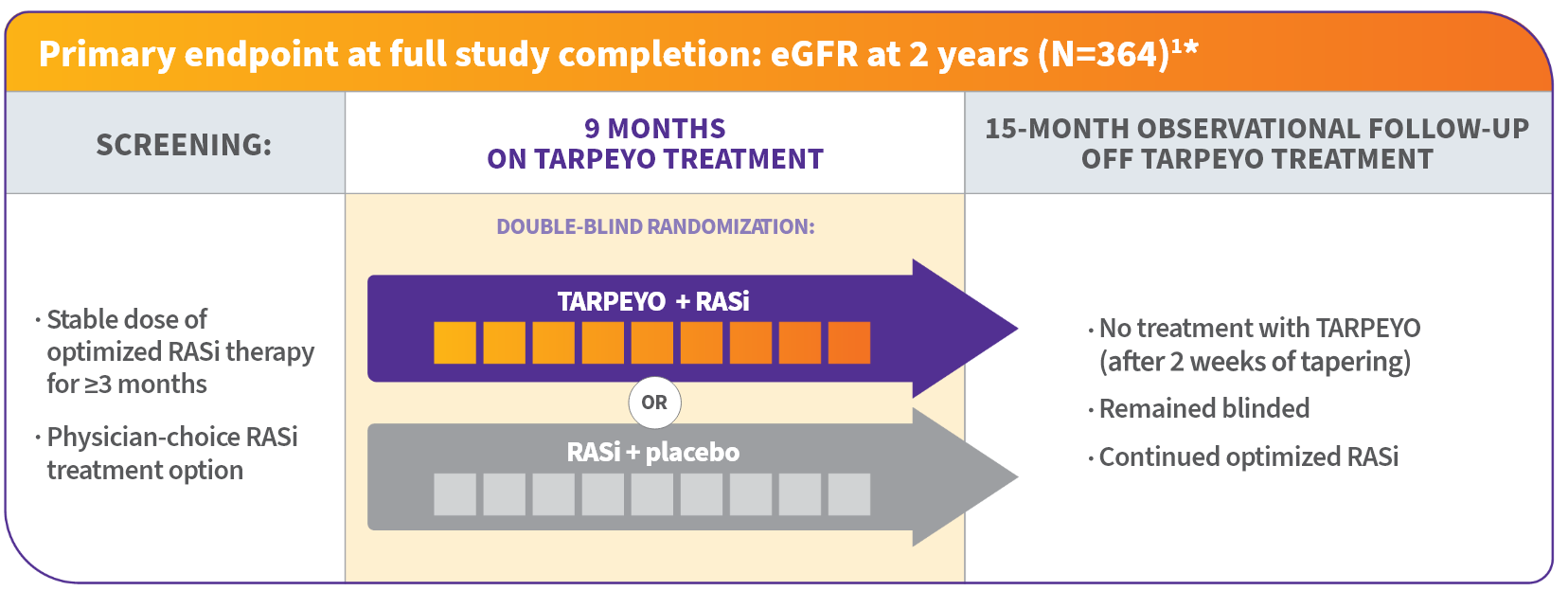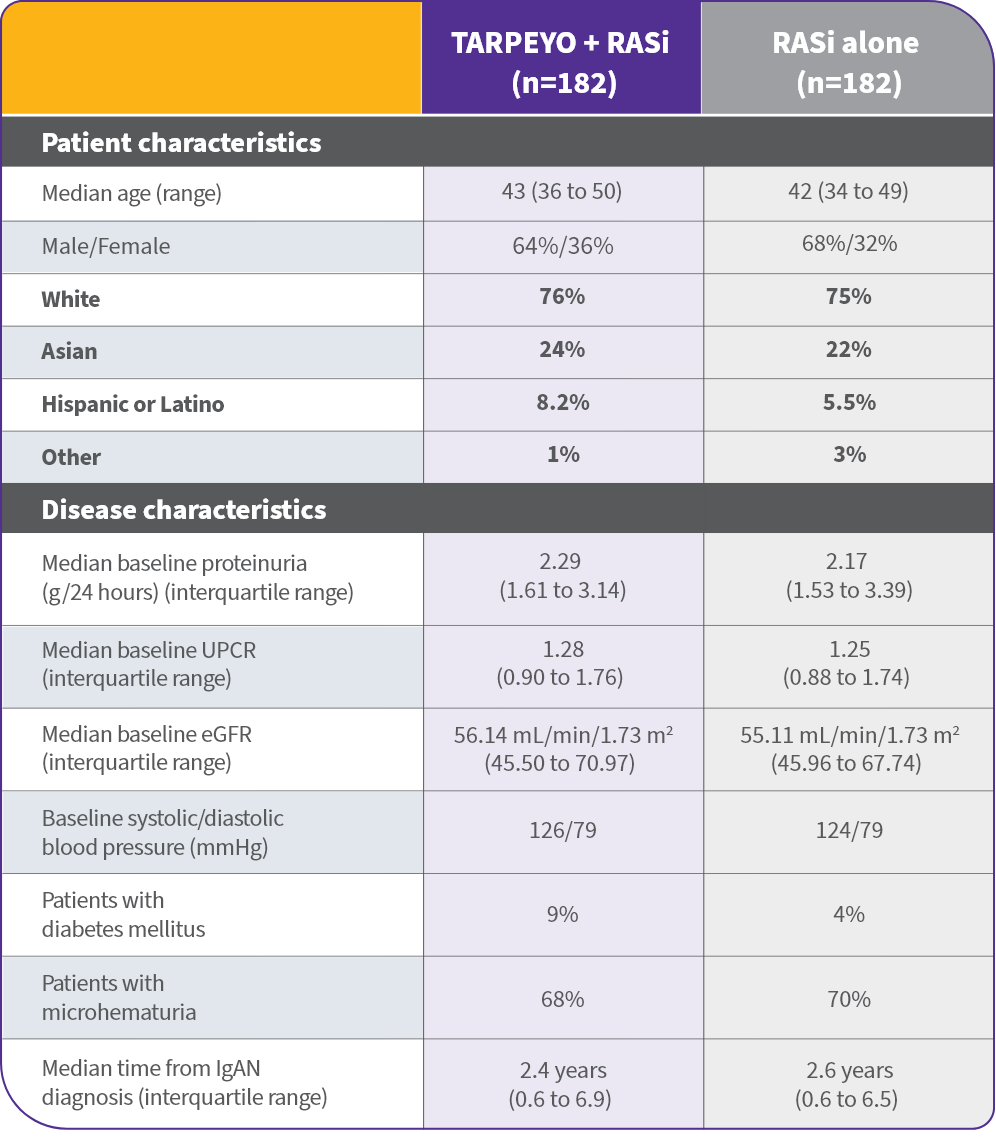Indication
TARPEYO is indicated to reduce the loss of kidney function in adults with primary immunoglobulin A nephropathy (IgAN) who are at risk for disease progression.
Important Safety Information
Contraindications:
TARPEYO is contraindicated in patients with hypersensitivity to budesonide or any of the ingredients of TARPEYO. Serious hypersensitivity reactions, including anaphylaxis, have occurred with other budesonide formulations.
Warnings and Precautions
Hypercorticism and adrenal axis suppression:
When corticosteroids are used chronically, systemic effects such as hypercorticism and adrenal suppression may occur. Corticosteroids can reduce the response of the hypothalamus-pituitary-adrenal (HPA) axis to stress. In situations where patients are subject to surgery or other stress situations, supplementation with a systemic corticosteroid is recommended. When discontinuing therapy or switching between corticosteroids, monitor for signs of adrenal axis suppression.
Patients with moderate to severe hepatic impairment (Child-Pugh Class B and C, respectively) could be at an increased risk of hypercorticism and adrenal axis suppression due to an increased systemic exposure to oral budesonide. Avoid use in patients with severe hepatic impairment (Child-Pugh Class C). Monitor for increased signs and/or symptoms of hypercorticism in patients with moderate hepatic impairment (Child-Pugh Class B).
Risks of immunosuppression:
Patients who are on drugs that suppress the immune system are more susceptible to infection than healthy individuals. Chickenpox and measles, for example, can have a more serious or even fatal course in susceptible patients or patients on immunosuppressive doses of corticosteroids. Avoid corticosteroid therapy in patients with active or quiescent tuberculosis infection; untreated fungal, bacterial, systemic viral, or parasitic infections, or ocular herpes simplex. Avoid exposure to active, easily-transmitted infections (e.g., chickenpox, measles). Corticosteroid therapy may decrease the immune response to some vaccines.
Other corticosteroid effects:
TARPEYO is a systemically available corticosteroid and is expected to cause related adverse reactions. Monitor patients with hypertension, prediabetes, diabetes mellitus, osteoporosis, peptic ulcer, glaucoma or cataracts, or with a family history of diabetes or glaucoma, or with any other condition where corticosteroids may have unwanted effects.
Adverse reactions:
In clinical studies, the most common adverse reactions with TARPEYO (occurring in ≥5% of TARPEYO treated patients, and ≥2% higher than placebo) were peripheral edema (17%), hypertension (12%), muscle spasms (12%), acne (11%), headache (10%), upper respiratory tract infection (8%), face edema (8%), weight increased (7%), dyspepsia (7%), dermatitis (6%), arthralgia (6%), and white blood cell count increased (6%).
Drug interactions:
Budesonide is a substrate for CYP3A4. Avoid use with potent CYP3A4 inhibitors, such as ketoconazole, itraconazole, ritonavir, indinavir, saquinavir, erythromycin, and cyclosporine. Avoid ingestion of grapefruit juice with TARPEYO. Intake of grapefruit juice, which inhibits CYP3A4 activity, can increase the systemic exposure to budesonide.
Use in specific populations
Pregnancy:
The available data from published case series, epidemiological studies, and reviews with oral budesonide use in pregnant women have not identified a drug-associated risk of major birth defects, miscarriage, or other adverse maternal or fetal outcomes. There are risks to the mother and fetus associated with IgAN. Infants exposed to in-utero corticosteroids, including budesonide, are at risk for hypoadrenalism.
References: 1. TARPEYO. Prescribing Information. Calliditas Therapeutics AB; December 2023. 2. Lafayette R, Kristensen J, Stone A, et al. Efficacy and safety of a targeted-release formulation of budesonide in patients with primary IgA nephropathy (NefIgArd): 2-year results from a randomised phase 3 trial. Lancet. 2023. https://doi.org/10.1016/S0140-6736(23)01554-4 3. Pitcher D, Braddon F, Hendry B, et al. Long-term outcomes in IgA nephropathy. CGASN. 2023;18. 4. KDIGO Clinical Practice Guideline for Glomerulonephritis. 2021. 5. Barratt J, Rovin BH, Cattran D, et al. Why target the gut to treat IgA nephropathy? Kidney Int Rep. 2020;5(10):1620-1624. doi:10.1016/j.ekir.2020.08.009 6. Lafayette R, Kelepouris E. Immunoglobulin A Nephropathy: advances in understanding of pathogenesis and treatment. Am J Nephrol. 2018. doi:10.1159/000481636 7. Data on file Part B. Calliditas Therapeutics AB. 8. Wimbury D, Muto M, Bhachu J, et al. Targeted-release budesonide modifies key pathogenic biomarkers in immunoglobulin A nephropathy: insights from the NEFIGAN trial. Kid Int. 2023. https://doi.org/ 10.1016/j.kint.2023.11.003 9. Chang S, Li X-K. The role of immune modulation in pathogenesis of IgA nephropathy. Front Med (Lausanne). 2020;7:92. doi:10.3389/fmed.2020.00092 10. Cotton V, Nawaz N, Molyneux K, et al. Analysis of the NefIgArd Part A study population confirms Nefecon suppresses circulating levels of IgA-containing immune complexes in IgA nephropathy. Leicester IgAN research group. Poster presented at IIgANN Congress; September 28-30, 2023. 11. Dressman J, Philipson R, Barratt J. Comparison of the dissolution profile of Nefecon with three other commercially available oral formulations of budesonide: implications for interchangeability. Abstract presented at IIgANN Congress; September 28-30, 2023. 12. Data on file. Calliditas Therapeutics AB.




